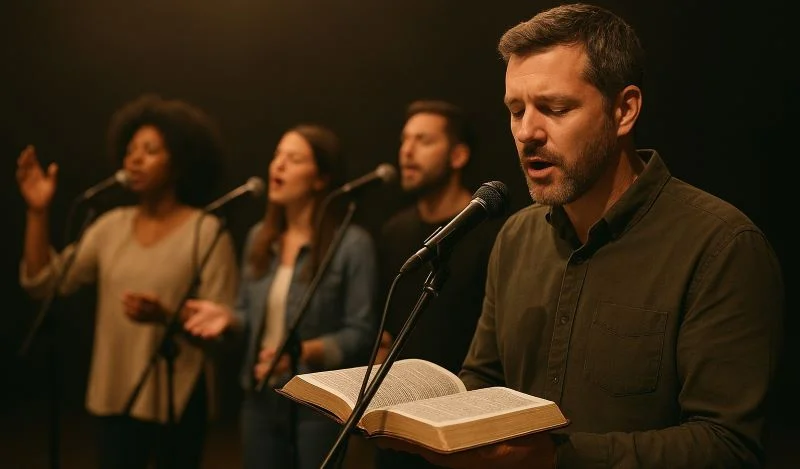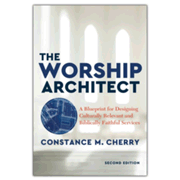
If you’ve been in a worship service for any length of time, you’ve probably heard it:
“Come on, church! Lift your hands! Sing it out!”
I’ve noticed this often, especially during transitions between songs. When I was based in the Middle East, several worship leaders I served with used those same lines. My first instinct was to gently talk to them afterward, but I hesitated. Their hearts were sincere; they simply wanted the congregation to engage.
Still, something stirred inside me. I thought, What if, instead of repeating the same phrases, we filled those moments with God’s Word? What if our transitions, the quiet, in-between moments, became opportunities to declare Scripture that leads people directly to Him?
After years of serving as a musician and worship leader, I’ve realized that Scripture can transform worship. It reminds us that the power isn’t in our words but in His. In this post, I’ll share why, how, and when to use Bible verses in worship, drawing from both personal experience and biblical foundation.
If you’ve ever struggled with what to say between songs or want your worship leading to be more Spirit-led and Scripture-centered, this is for you.
Why Scripture Belongs at the Heart of Worship
True worship is our response to who God is and what He has done. Without Scripture as our foundation, worship can easily drift toward emotion or performance. God’s Word keeps us anchored in truth and ensures our songs reflect His character, not just our feelings.
As I shared in Worship Through Music: What the Bible Says About Praise, music becomes genuine worship only when it’s grounded in the truth of God’s Word. When we read or speak Scripture during a worship service, we’re not adding something extra; we’re returning to the very source of our praise.
Hebrews 4:12 reminds us that “the Word of God is living and active.” When spoken aloud, it pierces hearts in ways our own words never could. No amount of energy or musical excellence can replace the transforming power of Scripture; it refocuses hearts and points every voice back to Christ.
Using Scripture also shifts attention away from the worship leader and back to God. Worship isn’t about the person with the microphone; it’s about exalting the Lord together. When the congregation hears the Word, they respond not to us, but to Him.
When and Where to Weave Scripture Into Worship

Through the years, I’ve found that God’s Word fits beautifully throughout a service. Here are some natural moments where it can flow seamlessly.
1️⃣ The Call to Worship
The start of a service is the perfect time to anchor hearts in truth. Instead of saying, “Let’s all stand and worship,” open with a verse that invites everyone to respond to God:
“Oh come, let us sing to the LORD; let us make a joyful noise to the rock of our salvation.” — Psalm 95:1–2
Beginning with Scripture reminds everyone that it’s God Himself who invites us into His presence.
2️⃣ Between Songs — Scripture as Transition
Instead of repeating “Come on, church,” use a verse that connects your songs.
- Before “Goodness of God”, share Psalm 23:6: “Surely goodness and mercy shall follow me all the days of my life.”
- After a song about surrender, read Romans 12:1: “Present your bodies as a living sacrifice, holy and acceptable to God.”
When Scripture bridges your songs, the atmosphere becomes more reverent and Spirit-led. The Word itself leads hearts deeper into worship.
3️⃣ During Instrumental Interludes
When the music softens, a short verse spoken over the melody can draw the congregation into stillness:
- Psalm 46:10 — “Be still, and know that I am God.”
- Isaiah 40:31 — “Those who wait on the LORD shall renew their strength.”
These simple truths remind everyone to rest in His presence, not rush through it.
4️⃣ Responsive Readings
Responsive readings invite participation and unity.
Leader: “Bless the LORD, O my soul; and all that is within me, bless His holy name!”
Congregation: “Bless the LORD, O my soul, and forget not all His benefits.” — Psalm 103:1–2
This shared declaration reinforces Scripture and draws hearts together in praise.
5️⃣ Before or After the Sermon
Reading Scripture before the message prepares hearts to receive; reading afterward helps seal the Word in their spirits. It’s a simple yet powerful way to frame the preaching of God’s Word.
Choosing and Delivering Scripture Well
When selecting Scripture, match verses to the theme or song set. If your focus is on God’s faithfulness, choose passages about His steadfast love and promises. The right verse adds both theological depth and emotional resonance.
Keep your reading short and clear. Sometimes a single verse says more than a long passage. Speak slowly and reverently, allowing space for reflection before and after.
Preparation is key. Don’t wait until Sunday morning to choose verses. Spend time in prayer throughout the week, asking the Holy Spirit to highlight passages that fit the flow of worship.
If your church uses screens, display the verses while reading them. When people both see and hear the Word, they’re more likely to remember it.
How Incorporating Scripture Transforms Worship

When worship leaders use Scripture intentionally, everything changes:
- It deepens engagement—people don’t just sing lyrics; they encounter the living Word.
- It builds biblical literacy—repeated exposure helps believers remember Scripture.
- It shifts the atmosphere—from hype to holiness.
- It strengthens the leader—reading the Word cultivates humility and confidence in God, not self.
As I mentioned in The Role of Emotion in Worship: Balancing Heart and Mind, Scripture anchors our passion in truth and gives depth to our praise.
Practical Tips for Worship Leaders
- Train your team. Explain why Scripture matters and where it fits best.
- Rehearse transitions. Practice reading verses aloud during run-throughs.
- Memorize short passages. It helps when you’re led by the Spirit mid-service.
- Create a “Scripture Bank.” Collect verses by theme: faith, hope, healing, gratitude, surrender, etc.
- Start small. One or two Scripture moments per service is enough.
- Seek feedback. Ask your pastor or team what feels most effective spiritually.
Sample Worship Flow (With Scripture Integration)
Here’s an example of how Scripture can guide an entire worship set:
1️⃣ Call to Worship: Psalm 95:1–2
“Oh come, let us sing to the LORD; let us make a joyful noise to the rock of our salvation.”
2️⃣ Opening Song: Come, Now Is the Time to Worship
Invites the congregation to respond joyfully to God’s call.
3️⃣ Transition Scripture: Philippians 2:9–11
“Therefore, God has highly exalted Him and bestowed on Him the name that is above every name…”
4️⃣ Song of Exaltation: How Great Is Our God
A natural continuation, lifting high the majesty of Christ.
5️⃣ Responsive Reading: Psalm 103:1–5
The congregation blesses the Lord together, remembering His goodness.
6️⃣ Closing Song: Goodness of God
A heartfelt declaration of gratitude and trust.
7️⃣ Benediction: Numbers 6:24–26
“The LORD bless you and keep you; the LORD make His face shine upon you and be gracious to you…”
Conclusion: Let the Word Do the Work

When we lead worship with Scripture, we’re not filling silence or maintaining energy; we’re giving space for God to speak. His Word refocuses hearts and reminds us of who worship is really about.
That said, Scripture doesn’t need to be read between every song. There are moments when silence says more; when the congregation is in tune with the Holy Spirit, and awe fills the room. In those times, it’s perfectly right to move from praise to adoration without words. Sensitivity to the Spirit matters more than structure.
Our goal as worship leaders isn’t to fill every moment but to lead people into God’s presence. Sometimes that means proclaiming His Word; other times, it means stepping back and letting His presence speak for itself.
So next time you feel tempted to say, “Come on, church!”, pause and ask the Lord how He wants to move. Whether through a verse that calls hearts to attention or through a moment of stillness, let Scripture and the Spirit lead. That’s when worship becomes deeper, purer, and far more powerful.
Key Takeaway
True worship flows from the truth of God’s Word and the leading of His Spirit. Incorporating Scripture moves us from emotional hype to spiritual depth, helping both leaders and congregations encounter God in a more meaningful way.
Being Spirit-led also means knowing when to speak and when to stay silent. Whether through a verse or through stillness, let the Lord guide every moment.
Frequently Asked Questions (FAQs)
1️⃣ Do I need to memorize verses to use them in worship?
Not necessarily. Keep a few printed verses or a Scripture list with your setlist. Over time, you’ll memorize them naturally.
2️⃣ What if I’m nervous about reading Scripture in front of people?
Start small with short, familiar verses. You’ll grow confident as you see how the Word impacts hearts.
3️⃣ How can I encourage my team to start doing this?
Lead by example. As your team sees you weave Scripture naturally, they’ll be inspired to do the same.
4️⃣ Can this work in contemporary worship styles?
Absolutely. Whether your church sings hymns or modern songs, God’s Word transcends style.
5️⃣ Should I always read a verse between songs?
Not necessarily. If the Spirit is moving and the congregation is engaged, it’s okay to move seamlessly between songs. The key is staying sensitive to His leading.
Call to Action
If you found this helpful, share it with your worship team or church musicians.
Let’s bring God’s Word back to the center of our worship gatherings where it belongs.
For more guidance on leading worship with both heart and truth, explore my other articles on worship.
This post contains affiliate links, which means I may earn a commission at no extra cost to you if you make a purchase through one of these links. I only recommend products or services I trust and personally use. Thank you for supporting Biblical Christianity!
Recommended Resource
If you want to learn how to design worship services that stay true to Scripture while connecting with today’s congregation, The Worship Architect by Constance M. Cherry is a must-read resource.

|
The Worship Architect: A Blueprint for Designing Culturally Relevant and Biblically Faithful Services, 2nd Edition
By Constance M. Cherry A comprehensive, practical method for designing and fostering meaningful times of reverence. Worship professor Constance M. Cherry shows how to create services that are biblically faithful, historically aware, culturally relevant, and engaging for all participants. This revised edition includes updated illustrations, examples, and material on global and live-streamed worship. 352 pages, softcover (Baker). |
